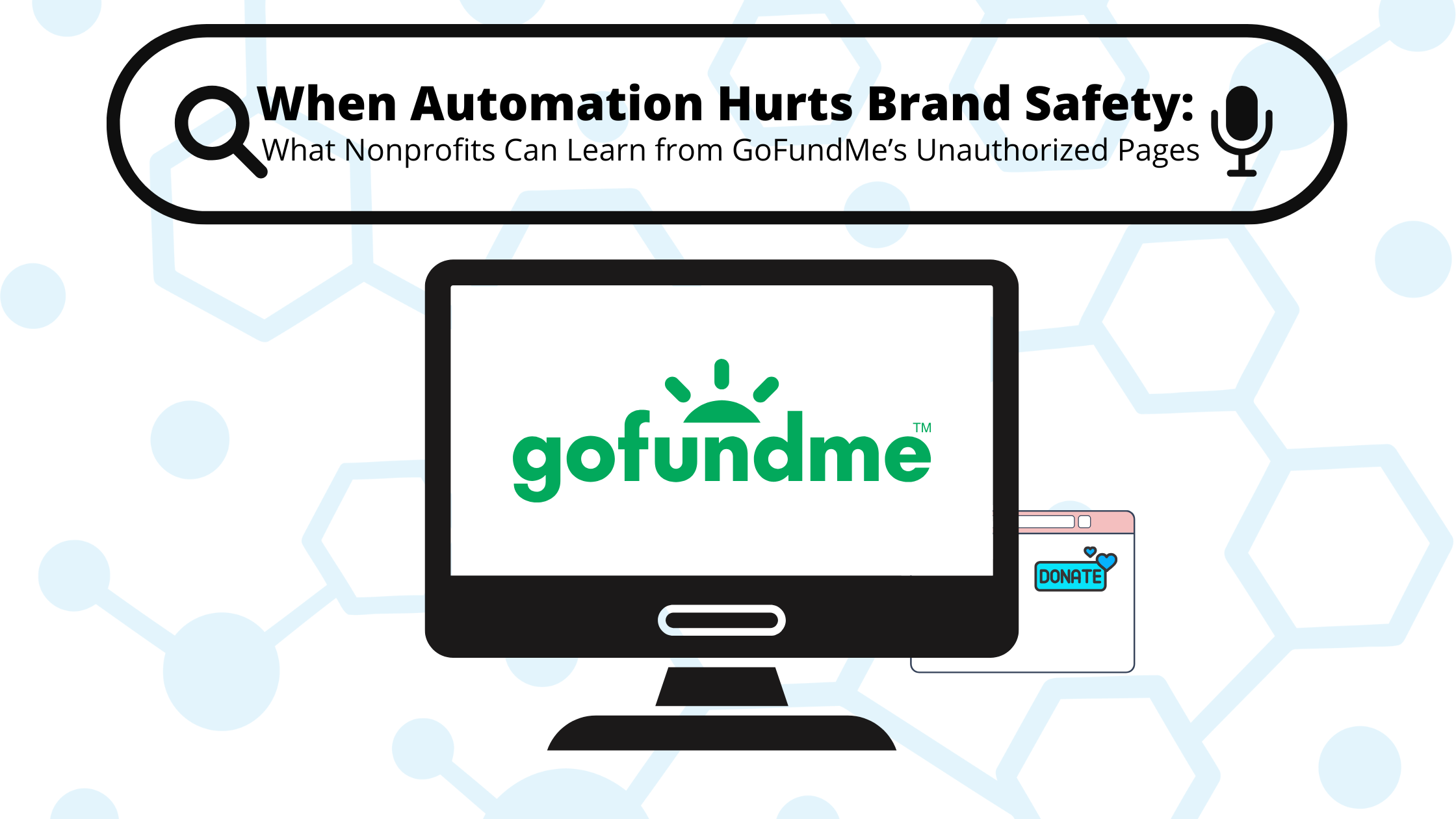When Automation Hurts Brand Safety: What Nonprofits Can Learn from GoFundMe’s Unauthorized Pages
In mid-October 2025, the nonprofit sector was blindsided by an unsettling revelation: GoFundMe quietly created more than 1.4 million donation pages for U.S. 501(c)(3) organizations without their knowledge or permission.
At first glance, it might look like a generous initiative to make giving easier. In practice, it exposed a much deeper issue at the intersection of automation, brand safety, and digital trust. For nonprofits that rely on public confidence and control of messaging, this kind of move is not just a technical problem. It is a brand safety concern hiding in plain sight.
The Automation Dilemma
Automation powers nearly every corner of the modern web. It helps nonprofits streamline donor management, run efficient ad campaigns, and keep their sites up to date. HDIC uses automation every single day. But when automation acts without consent, it stops being helpful and starts being harmful.
GoFundMe’s decision to auto-generate donation pages appears to have drawn data from public IRS filings, meaning every registered 501(c)(3) was fair game. Each of those pages included the nonprofit’s name, EIN, and a “Donate” button routing gifts through GoFundMe’s system, complete with platform tips and recurring gift defaults.
That might not sound malicious, but here’s the problem: donors often assume these pages are official. When people search for your organization by name and find a GoFundMe page above your actual website, their gift might go somewhere you never see, under terms you never approved.
Automation can be efficient. But when it overrides transparency, it endangers the very trust nonprofits depend on.
Brand Safety Beyond the Corporate World
Marketers usually talk about brand safety in the context of advertising: keeping ads off controversial websites or avoiding harmful associations. For nonprofits, brand safety goes deeper.
It means owning your identity online.
• Making sure donors land on your official donation form, not a third-party copy.
• Protecting your SEO authority so your own site, not a commercial platform, represents your mission in search results.
• Ensuring consistent, accurate messaging about your purpose and programs.
When a large platform duplicates your presence without permission, it chips away at all three. Even if GoFundMe’s intentions were benign, the outcome still compromises nonprofit control over their own brands.
Imagine spending years building your reputation, only to find another website with its own design, disclaimers, and monetization rules ranking above you for your own name. That’s the reality many organizations now face.
The SEO and Trust Fallout
From a search-engine perspective, these unauthorized GoFundMe pages are a double-edged sword.
GoFundMe is a high-authority domain, so its new pages often outrank smaller nonprofits’ websites. The result is SEO displacement, a phenomenon where a stronger domain crowds out smaller but more relevant results.
That displacement isn’t just cosmetic. If someone’s first click goes to a GoFundMe page instead of your site, they may never see your actual campaigns, volunteer opportunities, or impact stories. The donor relationship starts, and possibly ends, on someone else’s platform, on someone else’s terms.
Then there is the trust issue. Many donors assume GoFundMe keeps a small processing fee, but few understand how tips and recurring gift settings work. When the experience feels inconsistent or confusing, that confusion reflects back on you, not on GoFundMe.
Trust is the nonprofit world’s most valuable currency. Losing control of where and how donations are processed puts that currency at risk.
How to Check and Reclaim Your GoFundMe Page
If you are a registered 501(c)(3) organization in the United States, there is a strong chance GoFundMe created a donation page for your nonprofit automatically. You can verify and take action by following these steps:
Search for your page
Visit https://www.gofundme.com/charity/claim/search and enter your organization’s name or EIN. If a page exists, it will appear in the search results.Decide whether to claim or remove it
• If you want to manage the page directly, click “Claim” and follow the steps to verify your organization.
• If you prefer the page to be taken down entirely, you can email privacy-requests@gofundme.com or dpo@gofundme.com with your organization’s name and EIN, requesting removal. You can also submit a removal request through https://preferences.gofundme.com/.Check for existing donations before deactivation
Before requesting removal, log in through the claim process or contact GoFundMe support to confirm whether any donations have already been made to your page. If funds were received, you may need to verify your nonprofit’s banking information to access them before deactivation. Otherwise, those donations could remain in GoFundMe’s system indefinitely.Monitor search results after changes
Once you have claimed or removed your page, check Google and Bing search results over the following weeks. If the GoFundMe listing still appears, request that the link be removed from search indexes using Google Search Console’s “Remove Outdated Content” tool.
A Bigger Conversation About Consent and Control
This controversy touches something larger than one platform. As AI and automation increasingly mediate our online interactions, organizations of all kinds must confront the trade-offs between convenience and control.
It’s not enough to assume that platforms mean well. Every automated action involving your name, data, or donations carries brand and reputational implications. The safest organizations in this new landscape will treat brand safety not as a crisis response but as an ongoing discipline.
The irony is that nonprofits often need automation to stay lean, and there’s nothing wrong with that. Automation itself is not the enemy. Blind automation, detached from consent and accountability is, and the GoFundMe incident simply makes that lesson more apparent.
Reclaiming Ownership of Your Story
At HDIC, we work with nonprofits that care deeply about transparency and mission integrity, not only in the stories they share, but in the systems they rely on. Those values extend to every technical choice you make online.
If you discovered your organization has an unauthorized GoFundMe page, treat it as an opportunity to review your digital ecosystem. Are your official donation links easy to find? Are you monitoring your SEO for branded queries? Are your donor communications clear about how funds are processed?
Digital trust is earned one click at a time. When platforms overstep, the best response is not panic but proactive stewardship. Reassert your ownership of your data, your narrative, and your donor relationships. That is how real brand safety is built.
Resources
GoFundMe Claim Page: https://www.gofundme.com/charity/claim/search
GoFundMe Privacy Requests: privacy-requests@gofundme.com or dpo@gofundme.com
GoFundMe Preference Center: https://preferences.gofundme.com/
Google Remove Outdated Content Tool: https://search.google.com/search-console/remove-outdated-content
If you would like help auditing or securing your organization’s digital presence, contact us for a quick review. Brand safety is not just for advertisers. It is for every organization that values trust.

